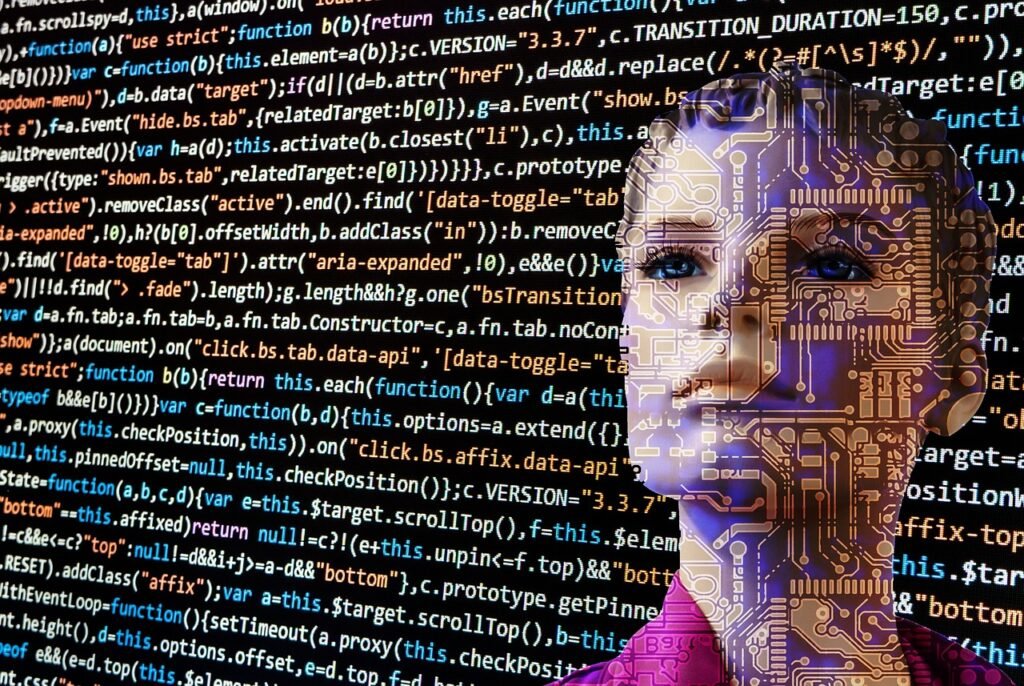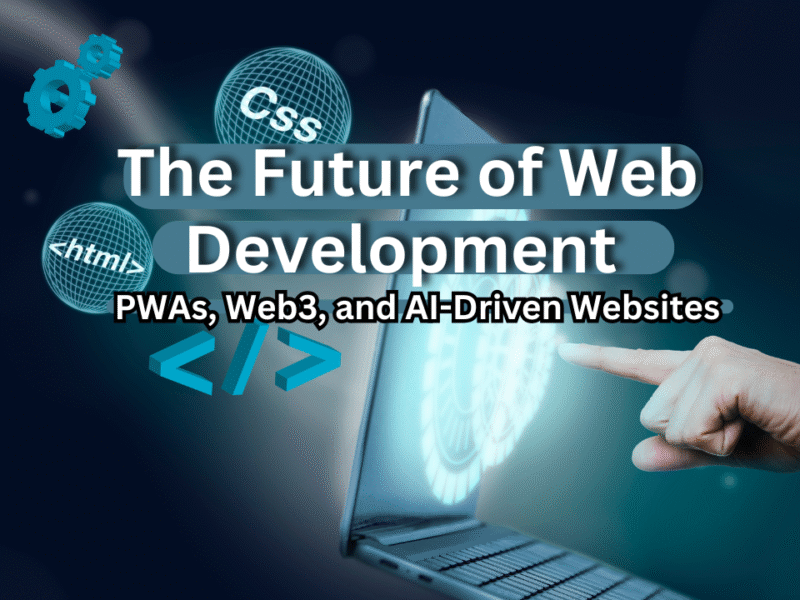Shaping the Digital World Ahead
Back when I started working on HTML, the web felt basic, but now, it’s a world of dynamic, AI-driven, intelligent change. The tools and technologies we use are constantly being reimagined, and staying ahead means embracing the latest frameworks and models. As a developer, I’ve seen how apps are now created to be hyper-personalized and seamless, connecting users with modern platforms that drive revenue and enhance engagement.
In 2025, businesses aren’t just “going online,” they’re crafting digital-first experiences using AI, blockchain, and security-first designs. This shift supports operations and meets growing expectations for transparency, speed, and innovation. Through experiences shaped by creativity, enterprise, and advanced solutions, the internet has become a hub for both growth and meaningful connections. If we don’t learn, embrace change, and create, we risk falling behind in this evolving market.
Web Development Trends in 2025 — AI-Enhanced Progress
Web development in 2025 is all about AI and machine learning reshaping how sites are built. These aren’t just futuristic ideas anymore—they’re driving automation, improving efficiency, and making tools more intuitive. In my experience, using AI-powered platforms like Codex and Wix ADI cuts down manual effort. AI-driven chatbots, real-time personalization, and bug detection are standard now. I’ve watched brands leverage these to gain a strategic advantage and improve user experience.
Companies are shifting from routine tasks to smart solutions, creating professional, personalized websites without writing code. Open AI’s Codex, for example, has saved hours of code generation for my team. Whether you’re a developer or a nontechnical user, these changes are real. By embracing automatic systems, we can offer faster, better, more engaging digital experiences for users and higher retention rates for businesses.

Shaping the New Era with AI-Powered Web Development
In my years building digital platforms, I’ve seen AI-powered tools go from being a novelty to a vital part of web development. In 2025, Artificial Intelligence (AI) will keep changing how web applications are made and used. Businesses will use AI to offer personalized experiences that users actually want. Developers can now work faster and smarter, thanks to smart AI integrations like auto-coding and smart debugging. What used to take hours can now be done in minutes—I’ve done it myself using tools like GitHub Copilot.
With smart AI-driven design, websites can now respond to user behaviors in real-time. AI reads user data and tailors layouts, content, and even prices. For example, AI tools can show relevant products or articles based on your browsing. When I tested this on an e-commerce project, we noticed better engagement and conversion rates. Chatbots powered by AI like GPT-4 are now capable of holding real conversations, enhancing customer support and increasing satisfaction without extra staff.
In the backend, AI helps developers with code generation, bug detection, and even layout structure. It can predict if a user will leave or buy something, so we can adjust design or offers immediately. Platforms like Netflix and Amazon use this strategy well—it’s what keeps people coming back. With tools like low-code platforms, even non-technical teams I’ve worked with have created useful prototypes, saving both time and budget. For me, this shift isn’t just about ease—it’s a whole new approach to creative thinking.

Web3 and the Shift Toward Decentralized Web Experiences
Over the last few years, I’ve explored Web3 through various projects and seen how it differs from Web2. While Web2 is shaped by centralized platforms, Web3 puts the power back into users’ hands. With decentralized applications (dApps), users have more control over their data and interactions. Built on blockchain technology, this ecosystem is more transparent, secure, and fair. The trust once placed in platforms is now placed in the code—something I found liberating during a recent dApp prototype I worked on.
The impact of blockchain on web development is already visible. It ensures enhanced security through immutable records and cryptographic methods. There’s transparency in every action, and decentralized hosting prevents single-point failures. In one client project, shifting to decentralized storage brought noticeable performance stability. These transformations are pushing the internet toward more resilient systems where control isn’t locked behind a single gatekeeper.
Web3 is more than theory—real-world use cases are driving its growth. Smart contracts trigger outcomes without middlemen, cutting costs and time. Digital tokens now represent real-world assets like art or real estate, which I’ve seen spark fresh interest in token-based platforms. Sectors like finance, gaming, and social media are adopting these models to give users both ownership and control. It’s changing how we define value and interaction online.
Of course, Web3 development isn’t challenge-free. I’ve faced scalability limits and a steep learning curve with new blockchain frameworks. Regulatory uncertainties add complexity. Yet the possibilities are vast. Developers can now build with better privacy, and early adopters in healthcare, supply chains, and finance are leading the way. The token-based model offers a more equitable digital economy—something that’s deeply needed today.
By 2025, Web3 and blockchain will reshape how we build web applications. Features like smart contracts, tokenization, and decentralized storage will become standard. I’ve already started to shift my own workflows to prepare for this. The promise is big: an internet where data is handled with more privacy, security, and user power than ever before.

Serverless Architecture in Web Development
As web development continues to evolve, serverless architecture is transforming how we approach building applications. With platforms like AWS Lambda, Azure Functions, and Google Cloud Functions, developers can now execute code without worrying about managing the underlying servers. This makes applications more scalable, cost-effective, and faster to develop. By relying on cloud providers to handle server management, scaling, and resource allocation, developers can focus on creating innovative features rather than infrastructure. As businesses shift toward cloud computing, serverless architecture is setting the stage for the next wave of real-time data processing and event-driven applications like file processing and notifications. In my experience, this approach simplifies web development and enables faster delivery, allowing for greater possibilities in microservices architectures and AI-driven websites.
Progressive Web Apps (PWAs) as the New Standard in Web Development
Progressive Web Apps (PWAs) are becoming the top choice for businesses focused on mobile-first strategies and better user experiences. They combine the speed of web apps with the powerful features of native mobile applications, creating a seamless digital solution. PWAs offer offline access, fast load times, and push notifications, helping businesses keep users engaged even without internet access. Big brands like Twitter, Starbucks, and Uber improved engagement and reduced app abandonment after switching to PWAs for mobile solutions. With 5G expansion and better browsers, PWAs are set to match native apps in both speed and performance. From my experience, PWAs are budget-friendly, help reach more users, and cut down the cost of web and app development.
AR/VR Integration Will Transform User Experiences
Augmented Reality (AR) and Virtual Reality (VR) are set to revolutionize how users interact with the web, expanding far beyond gaming and entertainment. By 2025, we’ll witness more websites integrating AR/VR elements to create immersive experiences. From virtual try-ons in e-commerce to interactive 3D tours for real estate, AR/VR will change the way users engage with content. In my view, the ability to offer virtual showrooms, interactive product experiences, and immersive training platforms will not only enhance user engagement but also provide unique ways to interact with brands. As more businesses adopt this technology, we’ll see an explosion of AR/VR-driven innovations that will redefine how we experience the web.

Low-code and No-code Platforms
Low-code and no-code platforms are revolutionizing the way web applications are developed. These platforms enable rapid development without requiring extensive programming knowledge, making web development accessible to non-technical teams. By democratizing web development, platforms like Webflow, Bubble, and OutSystems allow entrepreneurs, marketers, and small business owners to create valuable tools with ease. In my experience, this is a game-changer for businesses, accelerating the development process and fostering innovation. Beyond just building websites, no-code automation tools like Zapier and Make are transforming business operations by seamlessly integrating apps without writing code. The ability to quickly prototype, test market demand, and launch products without the overhead of hiring a development team makes these platforms indispensable for fast-paced businesses.
Utility-First CSS Frameworks: How Tailwind CSS is Challenging The Status Quo
Tailwind CSS is changing the game in web development with its utility-first philosophy. Unlike traditional frameworks like Bootstrap or Materialize, Tailwind gives developers the freedom to build unique, highly customized designs without fighting against pre-defined stylesheets. In my experience, this flexibility allows for more creative control and faster delivery. Speed and maintainability are key reasons why Tailwind CSS is gaining traction. Developers love its reusability and minimal bloat, enabling them to create sleek, high-performance interfaces efficiently. The expanding ecosystem, including tools like Tailwind UI and DaisyUI, is making Tailwind even more powerful. For businesses, this results in quicker development cycles and a stronger, more cohesive brand identity across all digital experiences.
Sustainability and Green Web Development
As climate change continues to be an urgent issue, the tech industry is taking action to reduce its environmental impact. By 2025, web developers will prioritize sustainability by optimizing code, reducing server loads, and using energy-efficient hosting solutions. Green web development practices are becoming a key focus for businesses aiming to align with eco-conscious consumers. In my opinion, this growing emphasis on sustainable technology will lead to lower carbon emissions, benefiting both the environment and a company’s image. With efficient coding and green hosting options, businesses can make a significant difference in the digital space. As consumers and businesses become more focused on sustainability, digital solutions that reflect these values will be expected.
Voice and Gesture-Based Interfaces Will Rise
As voice assistants and gesture-controlled devices become more widespread, web developers will need to adapt to new user interfaces. By 2025, voice search and voice navigation will be standard features on many websites, with gesture-based interfaces (such as swiping, pinching, and waving) enhancing user interactions on touchscreens and AR/VR devices. This shift requires developers to rethink how they design and build web experiences. With the rise of smart speakers and voice assistants, voice-driven interaction is becoming increasingly essential. Websites will need to be optimized for voice search and focus on user experiences that center around spoken commands. This evolution will make it easier for users to find information and complete tasks more efficiently.
Enhanced Personalization Through Machine Learning
As user expectations for personalized experiences continue to grow, machine learning will be essential in meeting these demands. By 2025, websites will utilize AI-driven algorithms to deliver hyper-personalized content, recommendations, and user interfaces tailored to individual preferences. This approach will not only enhance user engagement but also drive conversions and foster customer loyalty. The integration of machine learning will make it possible to predict and cater to each user’s unique needs, improving overall satisfaction.
Cybersecurity Will Be Non-Negotiable
As cyber threats continue to rise, security is becoming a crucial focus for web developers. By 2025, stricter regulations, advanced encryption methods, and AI-driven security tools will be essential to protect user data and prevent breaches. Developers must implement robust security measures throughout the development process to stay ahead. The adoption of secure coding standards, such as input validation, encryption, and secure authentication, will become vital. Web applications will increasingly rely on frameworks like Django and Ruby on Rails, which come with built-in security features to help mitigate common risks.
The growing number of cyberattacks targeting web applications demands that developers prioritize continuous security testing. Regular vulnerability assessments and penetration testing will help identify and fix flaws early. Additionally, AI-driven tools will play a significant role in detecting unusual behavior and automating threat response in real-time. These measures will make applications more resilient and prepared against future threats.

The Role of Developers Will Evolve
As automation and AI take over repetitive tasks, the role of web developers is shifting towards more creative and strategic functions. Developers will now focus on designing unique user experiences, integrating emerging technologies like AR/VR, and solving complex problems. This evolution in roles requires continuous learning and adaptability to stay ahead in this rapidly changing landscape. By 2025, developers will need to embrace their creativity, thinking beyond technical tasks to shape innovative digital solutions.
The future of web development is both exciting and dynamic. As technology evolves, developers will increasingly rely on AI-powered tools and immersive AR/VR experiences to create engaging digital experiences. To thrive in this environment, staying curious and adaptable will be key for developers to navigate the ever-changing web landscape, leading to new opportunities and challenges in web development.
Emerging Trends to Watch Out For in 2025 and Beyond
Sustainable Web Development Becomes a Priority
As the world shifts towards greener solutions, custom web development will follow suit, with companies prioritizing energy-efficient hosting, lightweight frameworks, and optimized code to reduce digital carbon footprints. By 2025, sustainable websites will not only reduce operational costs but also enhance brand reputation, especially as consumers become more eco-conscious. This focus on sustainability will drive the future of web development, aligning business practices with a growing demand for environmentally responsible solutions.
Voice-Driven Interfaces
Voice-driven interfaces are transforming web development by changing the way users interact with digital platforms. Natural language processing (NLP) and machine learning technologies allow voice assistants to understand user intent and preferences, providing highly personalized interactions. As these voice interfaces evolve, users will be able to speak instead of scrolling or typing, leading to more seamless and intuitive digital experiences. For businesses, e-commerce platforms are leveraging voice-driven shopping to improve the customer journey, allowing users to search, browse, and even complete purchases using simple voice commands.
The Impact of 5G on Web Speed and Accessibility
The rollout of 5G networks will revolutionize web experiences by significantly increasing internet speeds and reducing latency. This will enable faster load times, improved streaming, and more seamless interactions even in remote areas. For developers, this opens doors to building more bandwidth-intensive applications, such as augmented reality (AR) and real-time collaboration tools. Businesses will benefit from 5G by making rich web experiences accessible to users in underserved regions, enhancing the viability of cloud-based applications and eliminating the need for heavy local processing power.
Long-Term Impact of These Trends on Business and Technology
Web development is evolving beyond just coding. The future lies in leveraging emerging technologies to create seamless, intelligent, and high-performing digital experiences. Businesses and developers must stay agile to maintain a competitive edge. This includes adopting modern frameworks like Jamstack and Tailwind CSS, integrating AI and machine learning, and embracing low-code/no-code tools for faster project execution. Blockchain and Web3 technologies will drive decentralized infrastructures, ensuring secure and scalable applications.
Key Challenges in Custom Web Development in 2025
Evolving Cybersecurity Threats
As cyber threats become more sophisticated, developers must adopt a security-first mindset. With emerging risks such as AI-driven malware and deep fake phishing, the integration of advanced encryption, multi-factor authentication, and AI-driven threat detection systems will be crucial in safeguarding web applications. The Cybersecurity Forecast 2025 emphasizes the need for proactive and adaptive security measures to stay ahead of new threats.
Keeping Up With Rapid Technological Changes
The web development ecosystem is evolving rapidly, and staying current with the latest frameworks, tools, and libraries is essential for developers to maintain a competitive edge. Continuous learning, professional development, and participation in industry forums will help developers stay abreast of these changes. Organizations can support this by fostering a culture of learning and providing access to training resources.
Balancing Performance and Functionality
Ensuring optimal performance while delivering rich functionalities remains a critical challenge for developers. Users expect fast-loading applications, and failure to meet these expectations can lead to dissatisfaction. Developers will need to adopt strategies like optimizing web assets, utilizing CDNs, and embracing Progressive Web Apps (PWAs) to achieve the balance between performance and functionality.
Skill Gap in Emerging Technologies
The rapid rise of artificial intelligence, blockchain, and augmented reality has created a skills gap in the web development industry. Developers may face challenges in mastering these new technologies without sufficient training. To bridge this gap, organizations should invest in training programs and upskilling initiatives, ensuring that developers are equipped to implement cutting-edge solutions effectively.

Embracing the Future of Web Development
The Changing Landscape of Web Development
As we approach 2025, web development is rapidly evolving due to emerging technologies and the increasing demands of users. Key trends such as AI-powered website building tools, decentralized apps, and eco-friendly web practices are transforming how the internet is used. These advancements are not only enhancing user experience but also enabling businesses to stay competitive in a digitally-driven world.
Looking Ahead: The Role of Developers and Businesses
For both developers and businesses, embracing these trends is crucial for staying ahead. Upskilling in technologies like AI, blockchain, and advanced UI/UX design is essential. Businesses must also invest in sustainable digital solutions to remain relevant. At Imenso Software, we are dedicated to helping companies navigate these changes, offering expertise and strategic consultation to bring digital visions to life. Join us in shaping the future of web development today.
Most Popular Web Development Technologies in 2025
Front-End: Dynamic and AI-Enhanced Interfaces
The front-end of web development is seeing a major shift towards faster, more interactive applications, powered by AI. Leading technologies include:
- React.JS: The go-to choice for AI-driven UI components and component-based architecture, React remains a dominant player, especially with the new React Server Components that minimize client-side overhead.
- Svelte: Gaining popularity for its speed, Svelte eliminates the need for a virtual DOM, offering lightning-fast performance for speed-critical projects.
- Qwik.JS: A revolutionary framework focused on instant app loading and millisecond interactivity, ideal for high-traffic platforms like e-commerce.
- Tailwind CSS: This utility-first framework simplifies design creation, making it a favorite for responsive, fast-loading websites.
Back-End: Scalability and Performance
The back-end is all about handling scalability and performance efficiently, with leading technologies including:
- Node.JS and Deno: Node.js remains essential for microservices architectures, while Deno stands out for its security-first design and TypeScript support.
- Rust and Axum: Rust’s speed and memory safety have made it a top choice for high-performance applications, especially in blockchain and fintech industries.
- Go and Fiber: Go’s concurrency model is perfect for large-scale applications, while Fiber ensures lightweight performance for real-time apps.
- Laravel & Symfony: Despite newer technologies, PHP continues to thrive, with Laravel providing an elegant syntax for developers, and Symfony being a go-to solution for complex, scalable systems.
Real-World Case Studies: Successful Use of Emerging Technologies
Several companies are already leading the charge with these cutting-edge technologies:
- AI-Powered Personalization (Netflix & React Server Components): Netflix’s use of React and AI personalization has significantly enhanced global user experience, enabling dynamic rendering and reducing client-side processing.
- Web3 & Rust (Solana & Axum): Solana, a blockchain platform, uses Rust for security and performance, while Axum helps developers create high-speed decentralized applications (dApps).
- API-First Strategy (Stripe & Go/Fiber): Stripe uses Go and Fiber for API-driven architecture, enabling the processing of millions of transactions with minimal latency.

Frequently Asked Questions (FAQs)
1. What are the key trends in web development for 2025 and beyond?
The major trends include AI-driven website building tools, decentralized apps (dApps), voice-driven interfaces, and a growing emphasis on eco-friendly web practices. These trends are aimed at enhancing user experience, improving web performance, and making businesses more sustainable in the digital era.
2. How will AI impact web development in the coming years?
AI is transforming web development by enabling AI-powered interfaces, personalized user experiences, and automated design tools. It will help create smarter, more intuitive websites where users can interact via voice commands or personalized recommendations, making interactions more natural and efficient.
3. What technologies should developers focus on to stay relevant in 2025?
Developers should focus on technologies like React.JS, Svelte, Qwik.JS, and Tailwind CSS for front-end development. For back-end, Node.JS, Deno, Rust, and Go are key. Additionally, staying updated on AI, blockchain, and advanced UI/UX practices will be crucial for future-proofing their careers.
4. How does 5G technology affect web development?
The rollout of 5G will significantly improve web speed and accessibility by reducing latency and increasing bandwidth. This allows for faster load times, better-quality streaming, and more complex applications like augmented reality (AR) to work seamlessly, even in remote areas.
5. What are the challenges developers will face in 2025?
Some key challenges include evolving cybersecurity threats (such as AI-powered malware), keeping up with rapid technological changes, balancing performance with functionality, and addressing the skills gap in emerging technologies like AI, blockchain, and AR. Developers will need to continuously adapt and upskill to remain competitive.
conclusion
In conclusion, web development in 2025 is set to be defined by transformative trends, including AI integration, decentralized apps, and enhanced user interactions through voice-driven interfaces. As technologies like 5G and sustainable practices reshape the digital landscape, developers and businesses must stay agile and informed to remain competitive. Embracing these advancements, from new front-end frameworks to back-end scalability, will not only enhance user experiences but also improve business outcomes. The future of web development offers exciting opportunities, but success will require continuous learning, adaptability, and a proactive approach to emerging challenges and technologies.



